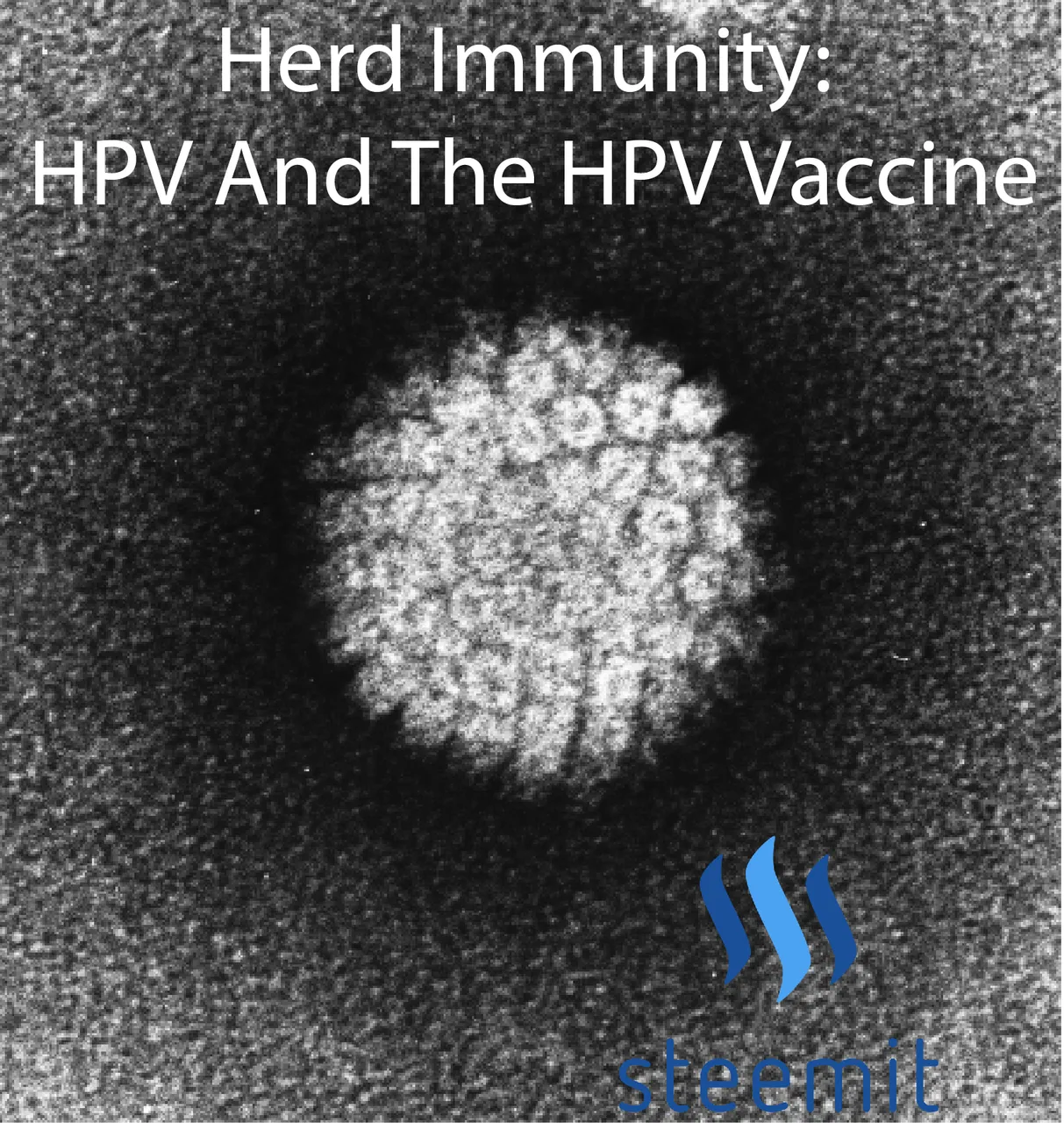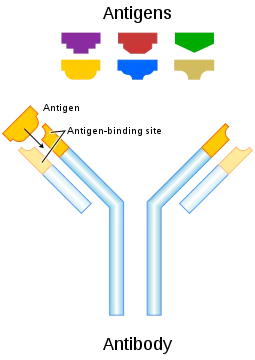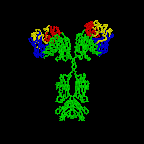Today I am going to write a brief post to discuss the Human Papillomavirus (HPV) vaccine. I will provide some background information about the virus itself, the complications which can arise from infection, methodology utilized for vaccination (how the vaccine works) and discuss some data recently published in the journal Obstetrics & Gynecology, titled "Change in Human Papillomavirus Prevalence Among U.S. Women Aged 18–59 Years, 2009–2014."
Disclaimer: I will not be engaging in discourse with those spreading an "anti-vax" agenda. I will not be responding to your comments. I also reserve the right to flag comments spreading that agenda in this post. I will ask you nicely here, please do not use this post as a sounding board for your opinions on this topic. You are free and welcome to express your own opinions with out the risk for censorship in your own posts. Thank you.

What Are Human Papillomaviruses?
Human Papillomaviruses are a group of DNA viruses (viruses come in two broad classes, those with genomes made of DNA and those with genomes made or RNA). There are currently over 189 known types of these viruses [2], and unsurprisingly when you get that many there are also five sub genra in which the viruses are further divided (Alphapapillomavirus, Betapapillomavirus, Gammapapillomavirus, Mupapillomavirus and Nupapillomavirus). [3]
HPV love to infect epithelial (surface) cells. Epithelial cells are those which are on the exterior of our organs, blood vessels, mucous membranes, genitals...etc. They are the cells which come into contact with the outside world (they touch blood, the air etc...). The reason HPV has its name is because upon infection it can result in the formation of a papilloma which is a non-cancerous (benign) tumor, aka a wart (yes that's right! A wart is a tumor). Warts are not particularly harmful when they are growing on the skin. However the skin is not the only place where HPV can infect.
Another location where HPV infection is common is common is our genitals. It is the source of the sexually transmitted disease known as genital warts, which can be spread through skin to skin contact. During sexy time (risky click?) skin to skin contact this can result in the transmission of HPV to a woman's cervix. Warts which grow there oftentimes lead to development of cancer. In fact, it has been identified that HPV infection is actually a NECESSARY factor in the development of these cervical cancers. [4] (Meaning you are ONLY going to get the cancer IF you have the viral infection)
Furthermore, it is also known that cancer only develops from certain varieties of HPV (you can have lots of gross genital warts and not get cancer if you don't have particular strains). These HPV types include: HPV 5, 6, 7, 9, 11, 16, 18, 31, 33, 35, 39, 45, 51, 52, 56, 58 and 59. [3]. Further research has identified the most common of these cancer causing variants in women (HPV 6, 11, 16, 18, and 45). [3]. Another not so fun fact is that HPV 6 and 11 cause up to 90% of all genital warts in the first place! [5] This may seem like a lot, however it is this knowledge which allows scientists to know specifically what to target to be able to come up with a way to help the most people.
The HPV Vaccine
So knowing which strains of the virus are the most prevalent, we can come up with a way to ramp up the immune system to be better at fighting them off. We call this methodology vaccination, and for HPV there are a few approved vaccines Cervarix which provides protection against HPV 16 and 18, Gardasil which protects against HPV 6, 11, 16 and 18 and the more recent Gardasil 9 which protects against types 6, 11, 16, 18, 31, 33, 45, 52 and 58 (All of which you will note are among the strains of the virus which are KNOWN to cause cervical cancer). [5], [6].
But what is the vaccine? How is it made? These vaccines utilize proteins that are a part of the viruses's outer shell to generate immunity (through production of antibodies by our immune system).
In short, viruses are enclosed by a shell. If you look at the title image above you can see the virus looks like a sphere with bumps and such on it right? Those bumps are actually proteins, which when the virus comes in contact with our cells allows them to gain access. When our immune systems are trying to fight the virus it needs to identify the foreign agent as a bad guy, and it does this through generation of proteins called antibodies.

Antibodies work with a lock and key like mechanism where they only interact with a very specific other thing, say for instance, a protein on the surface of a virus!
So HPV viruses utilize recombinant DNA technology and artificial production of these proteins which are a part of the viruses shell. The proteins are then injected as the vaccine, there is no virus there, just some lab grown virus parts.

The immune system then can detect these parts and create antibodies against them.
If the parts provided are from the coat of HPV6, then when a real HPV6 virus comes knocking on the door the antibodies will be waiting and ready. It will try to come in and quickly be tagged for destruction by the immune cells.
Recent Data, Herd Immunity and HPV Prevalence Rates Among Women
In the study mentioned at the top of the article [1. The authors were looking at how the numbers of people being diagnosed with HPV infections have been changing. Spefifically they were studying changes which occurred during the years 2009 to 2014.
They found, unsurprisingly that there has been a continued decrease in the number of people being diagnosed with HPV who have received one of the HPV-vaccines in the 18-26 year old age group going from 3.9% of the population of the age group in 2009 to only 2% in 2014. People who are being vaccinated are indeed being protected against the most common, cancer causing HPV viruses. The remaining 2% likely come from viral strains not vaccinated against.
However, interestingly, they also observed some trends for NON vaccinated women in the same age group. For these non vaccinated 18-26 year old women the percentage of the population diagnosed with an HPV infection fell from 19.5% in 2009 to only 9.7% in 2014.
Why might this be?
Well the authors state the answer is herd immunity. All of those immunized individuals are beginning to provide protection for even those who have not been immunized as these strains of the virus (6,11,16,18 and maybe some of types 31, 33, 45, 52 and 58 ) are not able to effectively spread through the population like they once could.
Conclusions
HPV is a DNA virus which is responsible for most if not all cases of cervical cancer. The main causative strains were identified and proteins from these viruses are used in vaccines to cause production of antibodies to protect people from infection. These vaccines have been reported to be extremely effective, and now evidence has been found showing that herd immunity is protecting even those not vaccinated.
Sources
Text Sources
- http://journals.lww.com/greenjournal/fulltext/2017/10000/Change_in_Human_Papillomavirus_Prevalence_Among.6.aspx
- http://www.sciencedirect.com/science/article/pii/S0042682210001005
- http://www.sciencedirect.com/science/article/pii/S0042682213004352
- https://www.ncbi.nlm.nih.gov/pubmed/26126623
- https://www.cancer.gov/about-cancer/causes-prevention/risk/infectious-agents/hpv-fact-sheet
- https://www.cancer.gov/types/cervical/research/gardasil9-prevents-more-HPV-types
Image Sources
All Non Cited Images Are From Pixabay.com, Flickr.com, Pexels.com, or Wikipedia.com And Are Available For Reuse Under Creative Commons Licenses
Any Gifs Are From Giphy.com and Are Also Available for Use Under Creative Commons Licences
If you like this work, please consider giving me a follow: @justtryme90. I am here to help spread scientific knowledge and break down primary publications in such a way so as to cut through the jargon and provide you the main conclusions in short (well compared to the original articles at least!) and easy to read posts.
SteemSTEM
Secondly, please consider supporting the @steemstem project. SteemSTEM is a community driven project which seeks to promote well written/informative Science Technology Engineering and Mathematics postings on Steemit. The project not only curates STEM posts on the platform through both voting and resteeming, but also re-distributes curation rewards as STEEM Power, to members of Steemit's growing scientific/tech community.
To learn more about the project please join us on steemit.chat (https://steemit.chat/channel/steemSTEM), we are always looking for people who want to help in our quest to increase the quality of STEM (and health) posts on our growing platform, and would love to hear from you!
